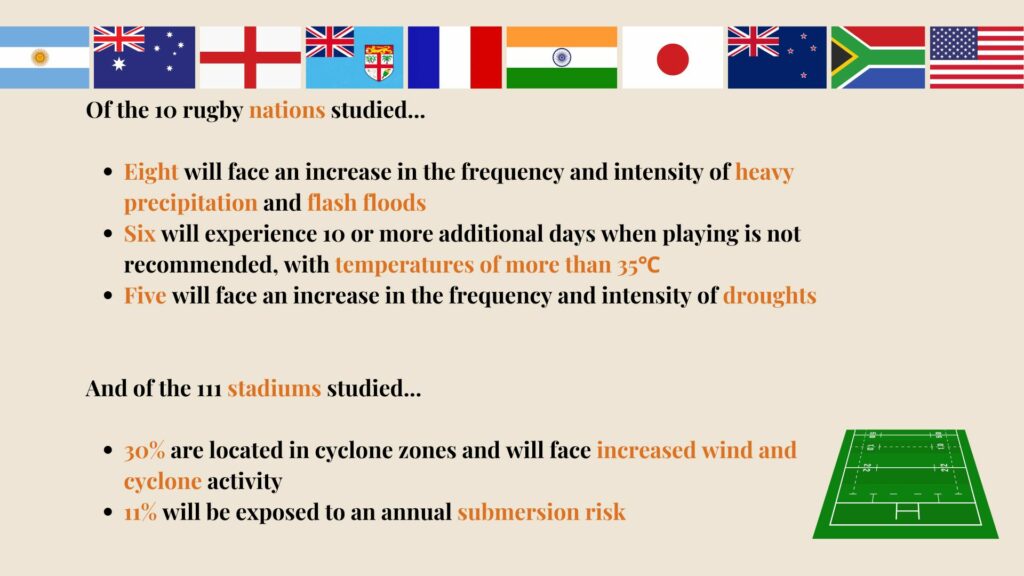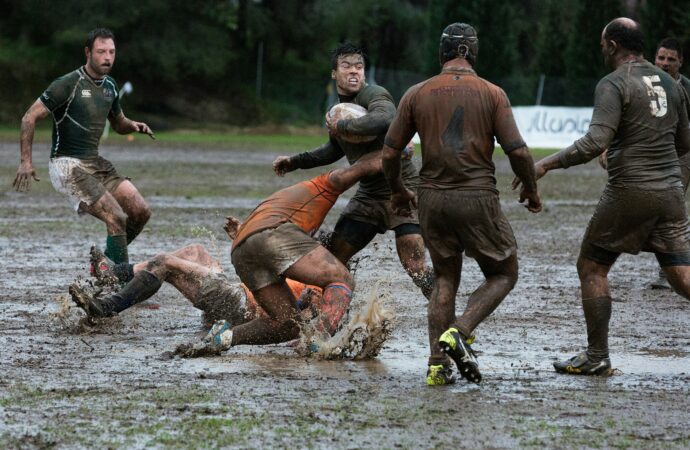Landmark report explores the game in a 2℃ world, and puts forward six recommendations for rugby community
The global rugby community has been encouraged to integrate climate projections into commercial and policy decisions as the sport faces a myriad of climate risks across all of its heartlands and key markets.
A landmark report published by World Rugby this week painted a concerning picture of what the sport could look like if global heating surpasses 2℃ above pre-industrial levels – a significant possibility if large-scale carbon reductions aren’t made quickly.
In that scenario, research presented by the international federation – reviewed by academics and experts, including Dr. Madeleine Orr and David Stubbs, as well as independent turf experts and member unions – demonstrates far ranging consequences.

To support the global climate change mitigation effort, and to adapt to the changing circumstances, World Rugby has put forward six recommendations; one of which includes looking at commercial and policy decisions through a climate lens.
This includes location and venue selection for future events and assessing infrastructure construction. There is also an emphasis on developing an economic model that is “compatible” with future climate conditions and avoiding commercial agreements with organisations that significantly contribute to the acceleration of climate change.
Amid criticism of Total Energies’ sponsorship of the 2023 Rugby World Cup, including objections from former Australia captain David Pocock, who authored the report’s foreword, World Rugby chief executive Alan Gilpin clarified that the partnership was arranged by the local organising committee and suggested that future World Cups, managed directly by World Rugby, would avoid partnerships with major oil and gas companies.
The rising cost of insurance and raw materials, which are a direct result of the climate crisis and its impacts, are also projected to affect the economic models of rugby clubs and event organisers globally.
“Not only is athlete and fan health at risk, but the ability to put events on and the business model behind sport is at risk,” says Jamie Farndale, rugby 7s captain for Scotland and sustainability ambassador for Scottish Rugby Union. “Some sports depend on only a few events and if these were cancelled there would be huge implications for the viability of the business.”
A separate but related recommendation from World Rugby is the development of shared management tools to improve visibility and understanding of climate risk, as well as direct risks like player health and performance, the degradation of playing fields and heat risks posed to spectators – an issue that Farndale points out is even more pronounced for grassroots clubs.
Management tools should be put in place, say World Rugby, to support monitoring and reporting of climate-related risks through the development of specific documents and guidelines around human resources, financial resources, infrastructure, processes, network and natural resources.

The fast-evolving nature of the climate crisis means that keeping these documents and guidelines up-to-date is crucial, particularly considering that many of the future World Rugby World Cup locations have already been chosen all the way up to the Women’s World Cup in 2033 – when the world could look very different depending on the climate trajectory we take.
That tournament, as well as the Men’s World Cup two years earlier, will be held in the US, which, according to the report, faces significant consequences in a +2℃ world. For instance, up to 50% of the matches played during a regular season are likely to occur during a period with an increased number of hot days. And most regions in North America are also projected to experience an increase in frequency and severity of both droughts and flash floods.
In 2027 and 2029, Australia will host the men’s and women’s tournament respectively. In his foreword, Pocock expressed the climate issues his homeland was facing already, with bushfires blanketing his home city of Canberra in smoke in 2020, forcing his club to relocate its pre-season training 400 kilometres north. If we continue to the current climate trajectory, up to 100% of matches will be played in extreme heat.
“At that stage it becomes dangerous and potentially fatal to play,” Farndale tells The Sustainability Report. “Add to this the increased rainfall, flooding, drought and extreme weather impact laid out and it will become almost impossible to hold matches.
“To put this into context, the last 11 months consecutively were all above 1.5℃ of warming, so these terrifying impacts are not far away.”
Farndale echos the recommendations of the report by calling on the rugby community to “fight for every tenth of a degree”. To do that, World Rugby has laid out a further four action-oriented recommendations: develop and implement individual sustainability plans, establish a solidarity funding mechanism to support vulnerable communities, undertake further research and, lastly, to promote and support local climate change adaptation and mitigation strategies for rugby.
“The choices facing us may appear difficult and stark at first,” says Sir Bill Beaumont, chairman of World Rugby, in a message that could be applied to the whole sports industry, “but in reality, when faced with the alternatives, they are really quite simple.”
To learn more about the research and the recommendations, you can read the full report here.
Opt into our weekly newsletter for exclusive content focused on sustainability strategy, communication and leadership for sport’s ecosystem.










Leave a Comment
Your email address will not be published. Required fields are marked with *